Read this blog post in: Português | ગુજરાતી
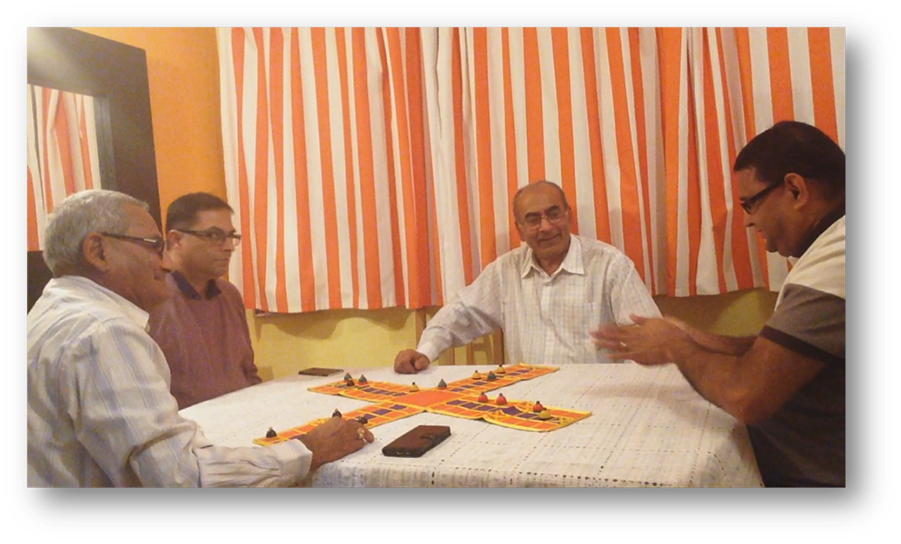
In this photograph, one can see, from the left to the right, Shreeman Surendra Manilal, moi même, Shreeman Rameshchandra Babulal and Shreeman Jayesh Jasvantalal playing the game of chopat.
Chopat (or Chaupat) is a Cross and Circle game played in Saurashtra, part of Gujarat, India. Also, the Vanzas and Darjis of Diu play Chopat, especially during Janmashtami and the month of Purushottam. There is a peculiar way in which they play this game. The players breathe excitement and rivalry against each other. The throws of the dice are accompanied with tremendous noise, and the sounds of "tutichaar", and "baar" and "ghodo" are heard from a considerable distance. It is altogether a lively scene.
Contents: One game board; 4 sets of pawns (each set contains 4) which are coloured Red, Green, Black and Yellow and a pair of stick dice (Paasa). See Fig. 1.
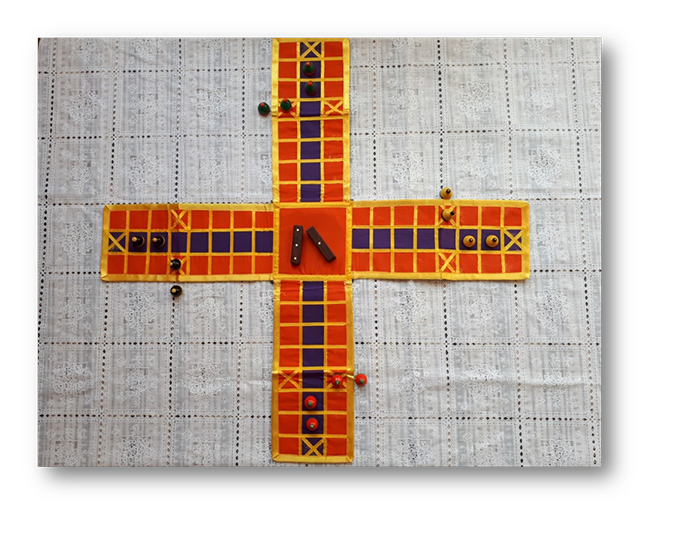
Fig. 1: In this photograph, one can see the embroidered "board" of chopat in a cross-shaped fabric, 4 sets of pawns (one red, one green, one black and one yellow) with 4 pawns each, and two stick dice (Paasa).
A chopat ‘board’ is traditionally an embroidered cloth in the shape of a cross. It has four arms joined at the sides of a big central square which is the ‘Home’ (Ghar). Each arm is made up of three rows of eight squares. We shall call the ‘home-arms’ of Red, Green, Black and Yellow as Red- Arm, Green-Arm, Black-Arm and Yellow-Arm, respectively. Red pawns go around the board starting from and ending at the Red-Arm. Similarly, other pawns start their journeys on their respective ‘home-arms’. Given below (as a white arrow line) in Fig.2 is the path of the Black pawns.
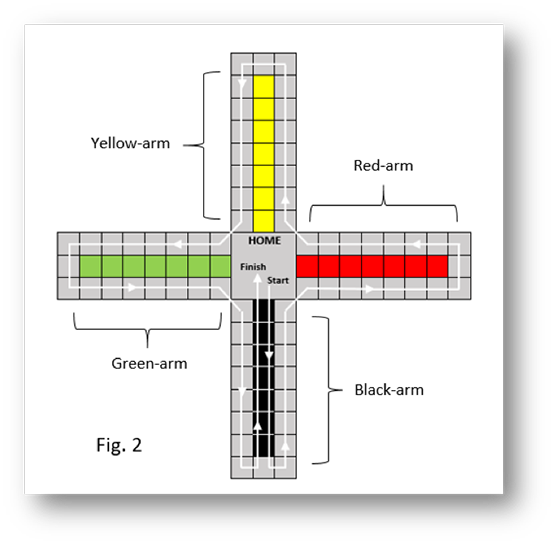
Fig. 2 shows the path of the Black pawns with a white arrow line. Diagram created by Diya Dipac.
The pawns (Sogthi or Sogthan) are usually made of wood. Each player has four pawns.
Chopat is a race game in which two or four players can play. Given here is the rule for a four-player game.
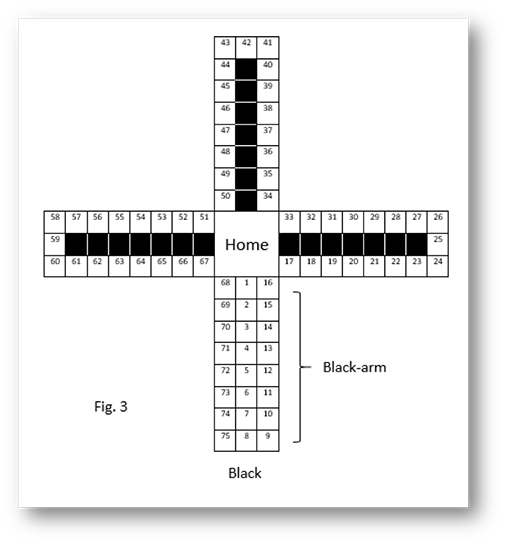
Fig. 3 shows the chopat game board from the Black player’s point-of-view. Diagram created by Diya Dipac.
Fig.3 shows the game board from the Black player’s point-of-view. Some squares are sequentially numbered from 1 to 75 while others have been blackened. The numbering originates from the home-arm of Black. Squares 1 to 7 are collectively called Black’s Belly. The Belly is the private domain of one set of pawns wherein pawns of other sets cannot venture. Blackened squares in Fig.3 depict the Bellies of other pawn-sets and hence Black pawns cannot move into those squares. The Black pawns start from their Belly, move from 1 to 75 sequentially, then to 8, go down the Belly to 1, and finally plunge into ‘Home’ as given below:
1-2-3-4-5-…………………-72-73-74-75-8-7-6-5-4-3-2-1-Home.
Similarly, other pawns move around the board and come back to their respective home-arm, go down their Belly and into Home. The movement (anti-clockwise direction) is shown as an arrow in Fig.2.
The pawns begin on the board as shown in Fig.1, i.e., for the Black pawns, one pawn is kept on each of squares 6 and 7 while a pawn-pair is kept on the 12th square. The same is done for each set of pawns on their respective home-arm.
The four squares, 34, 51, 68 and 17, are especially designated to the purpose of Kajalvun. Each of these squares is called Kajalvanun Sthal.
The element of chance is provided by two stick dice (Paasa). A stick die has one of 1, 4, 6 and 3 dots on each of its four widest faces. Both dice are rubbed together and rolled onto the floor. The number of dots shown on the top faces of both dice depicts how many squares the player’s pawn(s) can move.
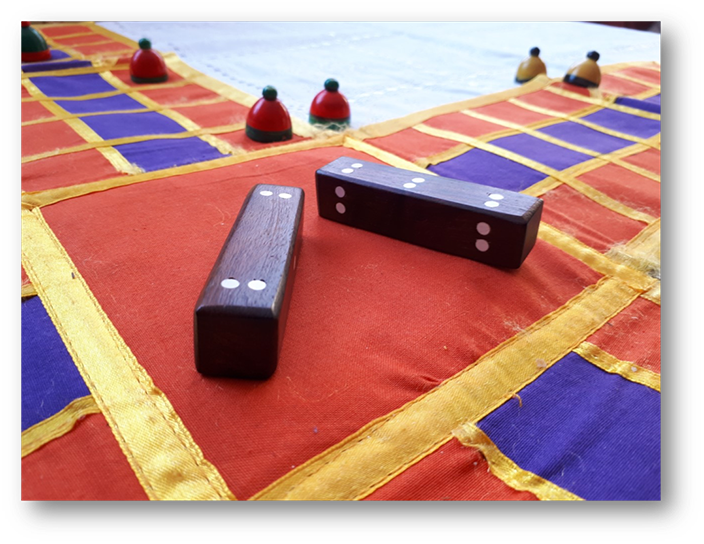
In this photograph, one can see the two stick dice called Paasa. The number of squares moved is indicated by the number of dots shown on the Paasa.
After having rolled the dice, say the top of one die shows 3 dots while that of the other shows 6 dots, the pawn(s) can be moved in one of two ways.
Case 1: One pawn is moved 3 squares, and another, 6 squares (always sequentially forward).
Case 2: Both numbers are added and only one pawn is moved i.e., in this case, one pawn is moved 9 squares (3+6).
How to Play Chopat
The player to start the game is the player with Black pawns.
Each of the player’s first pawns may leave their starting points, squares 12 (Black pawn), 29 (Red pawn), 46 (Yellow pawn) and 63 (Green pawn), on any throw. If a player on his first throw rolls a two or a twelve, the pawn-pair at square 12 (Black pawn), 29 (Red pawn), 46 (Yellow pawn) or 63 (Green pawn) is separated and the pawn is moved twelve squares forward to the corresponding square on the next arm of the cross i.e. square 24 (Black pawn), 41 (Red pawn), 58 (Yellow pawn) or 75 (Green pawn).
Each turn consists of two parts. First, the dice are thrown one or more times depending on the numbers thrown. And, only once throwing is completed is the pawn or are the pawns moved according to the dice throws. So, to begin a turn, the player throws the dice. If a doublet is thrown, the player is allowed another throw and so on until a 3, 4 or 5 is thrown. Then, for each throw made, the player moves one pawn as indicated by the amount on the dice. So if three throws were made, the player might move: one pawn three times or one pawn twice and another once or three pawns once each.
Forfeiting the turn voluntarily is not allowed. A throw cannot be passed in whole or part unless a player cannot move.
When both dice present the same number of dots on their top faces, it is called a doublet. A doublet (1,1 or 3,3 or 4,4 or 6,6) can be used either to move two individual pawns or a single pawn, or a pawn-pair can be moved together. There is no bonus turn for rolling a doublet until a pawn-pair (Jug) is formed at square 34 (Black Pawn), 51 (Red pawn), 68 (Yellow pawn) or 17 (Green pawn). If two pawns of the same colour come together on a square, they form a "pawn-pair."
No more than one pawn can occupy a square at the same time before a pawn-pair is formed at square 34 (Black pawn), 51 (Red pawn), 68 (Yellow pawn), or 17 (Green pawn).
A pawn-pair can only be moved when an even number is rolled by the player, and the number of squares moved gets halved (e.g. if a player rolls 2, 4, 6 or 12, the pawn-pair can move only 1, 2, 3 or 6 squares respectively).
A player’s objective is to form a pawn-pair at square 34 (Black pawn), 51 (Red pawn), 68 (Yellow pawn) and 17 (Green pawn). This is called Kajalvun. The square where a pawn-pair is formed is called Kajalvanun Sthal.
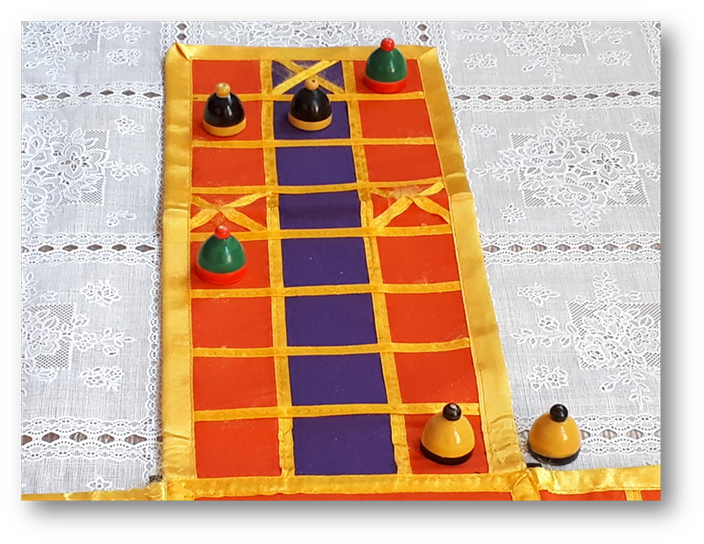
In this photograph, one can see the square where a yellow pawn-pair is formed. This act is called Kajalvun. The square where a pawn-pair is formed is called Kajalvanun Sthal.
After the pawn-pair at square 34 (Black pawn), 51 (Red pawn), 68 (Yellow pawn) or 17 (Green pawn) has moved together on the roll of a doublet, it has to be passed over by a single pawn of the player. This is called Ool Olangvun. On his next turn, the player can choose to break and separate the pawn-pair just by moving one or both pawns to different squares. Ool Olangvun is considered successful only if the pawn that has passed over the pawn-pair stays unharmed on the immediate turn of the opponent player sitting on his right. But if the single pawn is cut by the opponent player’s pawn immediately after it has passed over the pawn-pair, a repetition of Ool Olangvun will become obligatory until a pawn has passed over the pawn-pair successfully.
A pawn-pair may be moved together on the roll of a doublet after it has formed a pair at square 34 (Black pawn), 51 (Red pawn), 68 (Yellow pawn) or 17 (Green pawn). This is called Jugne Uthavavun. A pawn-pair cannot be moved together more than once on the roll of a doublet before it has been passed over by a single pawn of the player. For example, on the roll of multiple doublets (before Ool Olangvun is accomplished successfully), the player is allowed to advance the pawn-pair to a new square only once, according to the numbers on the first doublet rolled. If this pawn-pair is cut by the opponent player’s pawn-pair before it is passed over by a single pawn of the player (Ool Olangvun), it has to be removed from the board and must start again.
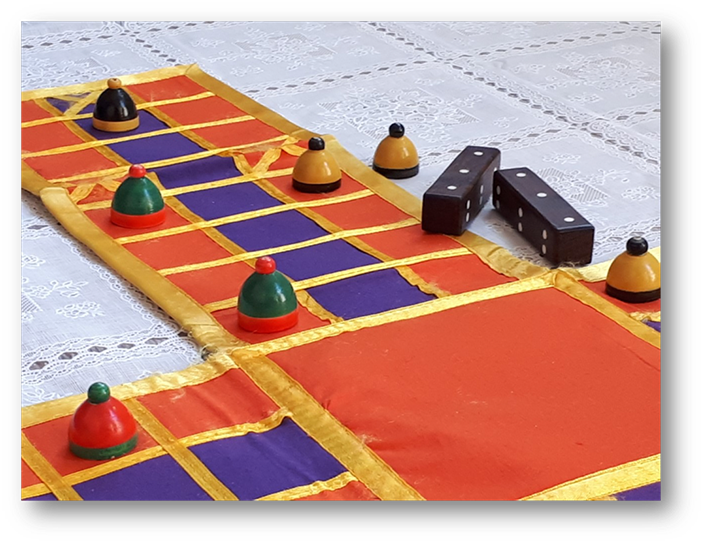
In this photograph, one can see the yellow pawn-pair that has been moved with the roll of a doublet. This is called Jugne Uthavavun.
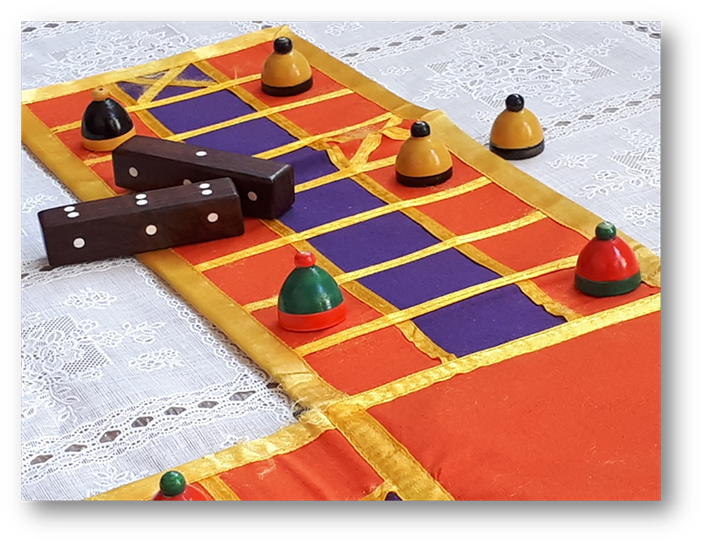
In this photograph, one can see the act of Ool Olangvun, where the yellow pawn-pair, after having been moved with the roll of a doublet, has been overtaken by another pawn of the same player.
The player may choose to not use a doublet roll to advance a pawn-pair formed at square 34 (Black pawn), 51 (Red pawn), 68 (Yellow pawn) and 17 (Green pawn). Instead, the player may choose to move other pawns or cut the opponent player’s pawn.
All cut pawns have to be removed from the board and must restart from the top of the Belly. This is called Sogthi Besaadvi. Until and unless all cut pawns are reintroduced on the board, a player cannot move his other pawns.
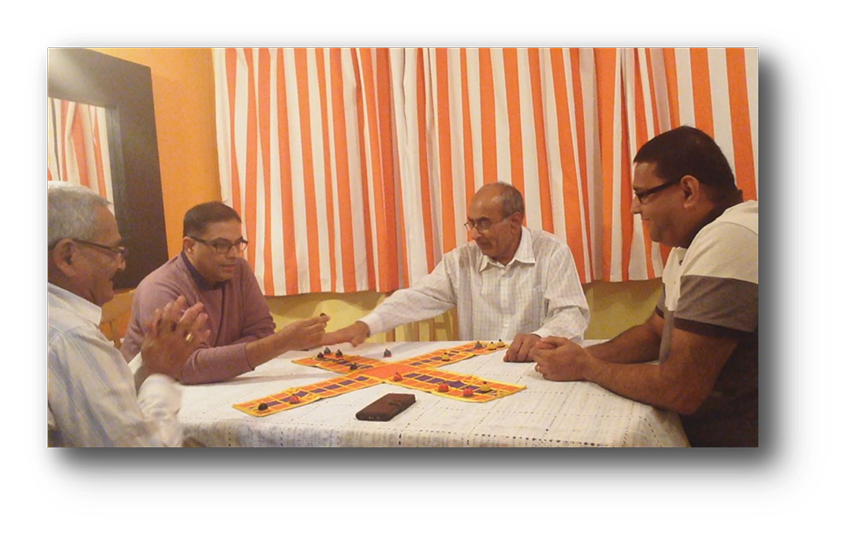
In this photograph, one can see a pawn in its Belly, recommencing its journey after having been cut by an opponent player’s pawn. This is called Sogthi Besaadvi.
A pawn is cut when an opponent pawn lands on the same square. This is called a Tod. A cut pawn is removed from the board for the time being. No matter where a pawn is cut, it has to start the race all over again beginning at square 1 in its Belly during its immediate next turn. For example, a player’s single pawn gets cut and during his next turn, he must place the cut pawn at the top of his Belly and move the pawn a number of squares as per either die or both numbers shown on the dice.
There is no bonus turn when a player cuts his opponent’s pawn. There is a bonus turn in this game during the roll of a doublet only after a pair-pawn is formed at square 34 (Black pawn), 51 (Red pawn), 68 (Yellow pawn) or 17 (Green pawn).
There are three ways in which a pawn that is either in Home or in its Belly is brought back into play. This pawn is allowed to cut only the opponent player’s pawn that has performed Ool Olangvun.
- Each player has his own Belly and may not enter another’s. So, when a pawn is in its Belly, it can no longer be captured by an opponent. Pawns can still be removed from the Belly or Home as long as no obstruction (pawn either on its way to enter Home or that has just entered into play) is encountered along the Belly.
- Each pawn enters the central square ‘’Home’’ only with the exact number of steps. If the throw is higher than the required number of steps, and if it cannot be used by any other of the player’s pawns still in play or in the Belly, the pawn has to be moved down the Belly and if it finishes on a square outside of the Belly, it has to make an additional circuit around the board.
- After a player has brought all of his pawns home, he can continue to play with the others. If all four of his pawns are in Home, he can bring one of their pawns into play. This is called Khado Karvo. This pawn can capture the opponent player’s pawn (the opponent player who is sitting on his right and who has performed Ool Olangvun successfully) directly without any throw of the dice if it is lying on any square of the outer perimeter of its arm on its way to enter the Belly. The opponent player’s partner’s pawn (the opponent player sitting on his left) on the same stretch cannot be captured directly. Instead, the player has to move his pawn according to the numbers received from rolling the dice. Similarly, two pawns can be brought into play by capturing the opponent player’s pawn-pair (the opponent player who is sitting on his right and who has performed Ool Olangvun successfully) directly without any throw of the dice if it is lying on any square of the outer perimeter of its arm on its way to enter the Belly.
After a player has brought all of his pawns home, he can continue to play with the others, either by bringing one of his pawns to play on his immediate turn or by missing his turn four times.
The game is played by two opponents who sit opposite each other with four pawns each, or is played by two partners versus two partners. The partners sit opposite each other. If either partner gets all of his pawns into Home, then that partner will miss his turn four times and then from the fifth turn onwards, he will aid his partner. For example, Partner A is playing with red pawns and Partner B is playing with green pawns. If Partner B gets all of his pawns into Home and then misses four turns, this means that every turn thereafter that Partners A and B play will be used to move the red pawns. On each of the four turns that Partner B misses, he hands one of his pawns that has entered Home to an opponent player in order to keep count of the number of turns he has missed.
If two pawns of the same colour come together on a square, they form a ‘’pawn-pair.’’ By default, all players have a pawn-pair at the beginning of the game. A player can choose to break and separate a pawn-pair at any given time just by moving one or both pawns (to different squares). Any pawn or pawn-pair can jump over another pawn-pair. The first pawn-pair to be made must be formed at square 34 (Black pawn), 51 (Red pawn), 68 (Yellow pawn), or 17 (Green pawn) before a pawn-pair of that colour can be formed again at any other square.
The roll of a doublet is required to move a pawn-pair. When a player forms two pawn-pairs during the game, he is requested by the opponent players to declare which pawn-pair out of the two holds a true status. The pawn-pair that holds a false status can be cut by a single pawn of the opponent player, whereas usually, only a pawn-pair can cut another pawn-pair (with the roll of a doublet). Two pawns of the same colour on separate squares cannot both land together on the square occupied by a pawn-pair. Such cutting is also not allowed. For example, a Green pawn-pair is on square 70 and there are two Red pawns, one on square 66 and another on square 67. Now, if the player with the Red pawns rolls a 3 and a 4 on the dice, it might seem that they could both form a pawn-pair at square 70 and hence, cut the Green pawn-pair present there, but they cannot, since a pawn-pair can be cut only by an already formed pawn-pair.
There are no safe squares in this game. A pawn or a pawn-pair is safe only in its Belly i.e., from squares 1 to 7.
A pawn that has entered its Belly on its way to Home has to be distinguished from other pawns that are still starting the race. Hence, such a Home-ward pawn is turned on its side while in the Belly. The exact number of dot/s on either die (or both dice) is required for a pawn to enter Home. The act of the pawn entering Home is called Sogthi Oothi Gai.
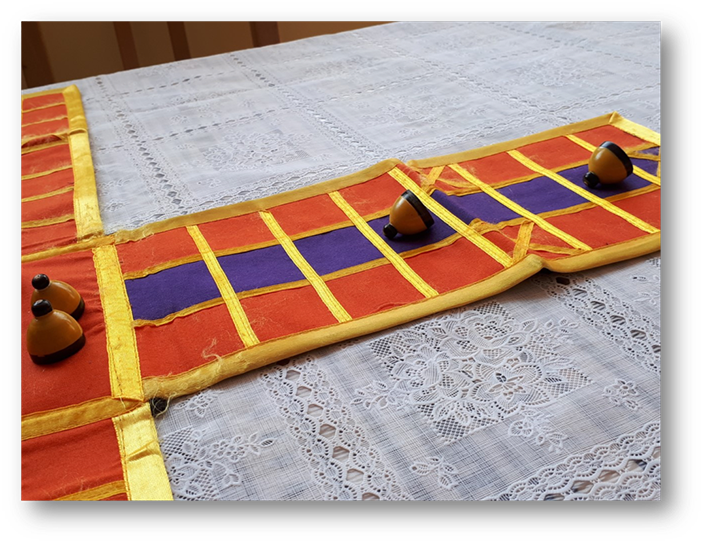
In this photograph, one can see two yellow pawns lying on their side in their Belly, on their way to Home.
The pawns that reach the central square Home in the game board are referred to as ‘laal’ or red. In most Indian board games, the pawns that are in the race are considered as raw fruits (this is called Kaachi) and once they reach their destination, ‘home’, they are said to ripen and turn red (this is called Paaki).
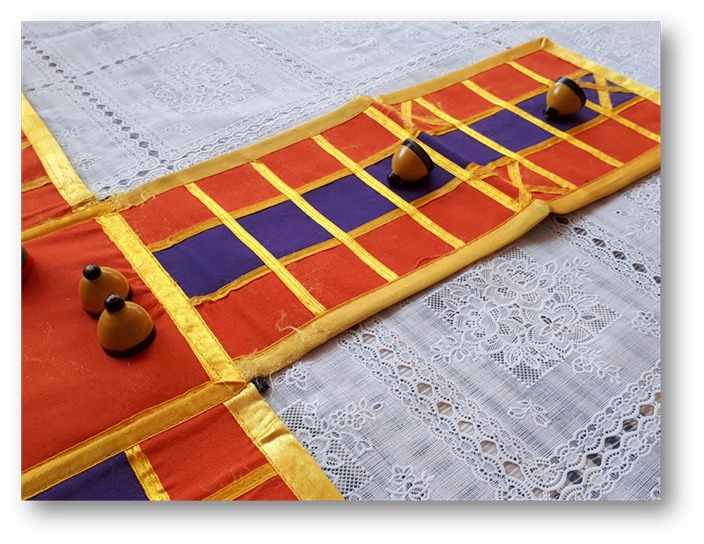
In this photograph, one can see two yellow pawns that have arrived at Home.
The first player to get all his four pawns into Home is the winner. Others can keep playing to get first runner-up, second runner-up, and the loser. In a partnership game, the team that first gets all its eight pawns into Home is the winner.
Post by Dipac Canacsinh
Acknowledgements
It is a pleasure to acknowledge the invaluable support and encouragement of my cousin Pradip Vassantlal during the accomplishment of this article and for the revision of its Gujarati version.
I am especially grateful to Mr. Rameshchandra Babulal for having clarified numerous questions concerning the rules of chopat.
I am also grateful to Diya Dipac for providing me with the photographs and diagrams used in this article.
My sincere gratitude to Shreemati Babita Champaclal for the excellent skill with which she filmed the documentary presented in this article. I also thank Aaryan Dipac for editing the video of the documentary presented in this article.
I thank Mr. Rameshchandra Babulal, Mr. Surendra Manilal and Mr. Jayesh Jasvantalal for sparing their invaluable time to participate in the game of chopat presented in the documentary.
I want to thank Mr. Dakshesh Hemendrarai for his colossal effort in arranging the video and audios in an aesthetic order under this article and the previous two.
Disclaimer
Throughout the article, gender-specific terms were used in order to ease the text flow. Whenever a gender-specific term is used, it should be understood as referring to both genders. This is done solely for the purpose of making the text easier to read, and no offense or sexism is intended.
Media
Find below some important soundtracks related to Chopat and definitely recommend watching the video below:

